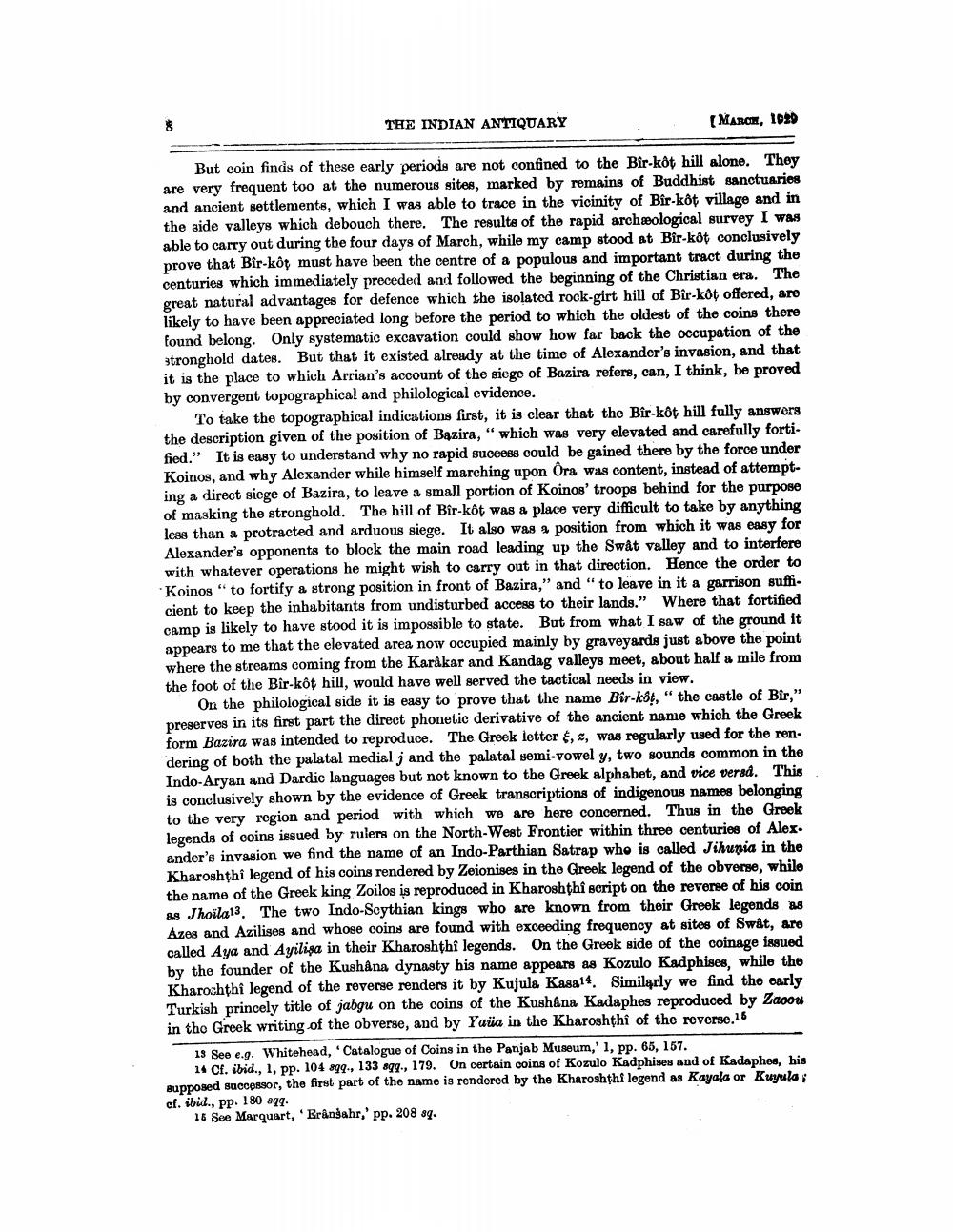________________
THE INDIAN ANTIQUARY
[MARCH, 1020
But coin finds of these early periods are not confined to the Bir-kôt hill alone. They are very frequent too at the numerous sites, marked by remains of Buddhist sanctuaries and ancient settlements, which I was able to trace in the vicinity of Bir-kôt village and in the aide valleys which debouch there. The results of the rapid archeological survey I was able to carry out during the four days of March, while my camp stood at Bir-kôt conclusively prove that Bir-kôț must have been the centre of a populous and important tract during the centuries which immediately preceded and followed the beginning of the Christian era. The great natural advantages for defence which the isolated rock-girt hill of Bîr-kôt offered, are likely to have been appreciated long before the period to which the oldest of the coins there found belong. Only systematic excavation could show how far back the occupation of the stronghold dates. But that it existed already at the time of Alexander's invasion, and that it is the place to which Arrian's account of the siege of Bazira refers, can, I think, be proved by convergent topographical and philological evidence.
To take the topographical indications first, it is clear that the Bîr-kôt hill fully answers the description given of the position of Bazira, " which was very elevated and carefully forti. fied." It is easy to understand why no rapid success could be gained there by the force under Koinos, and why Alexander while himself marching upon Ora was content, instead of attempting a direct siege of Bazira, to leave a small portion of Koinos' troops behind for the purpose of masking the stronghold. The hill of Bir-kôt was a place very difficult to take by anything less than a protracted and arduous siege. It also was e position from which it was easy for Alexander's opponents to block the main road leading up the Swat valley and to interfere with whatever operations he might wish to carry out in that direction. Hence the order to Koinos "to fortify a strong position in front of Bazira," and "to leave in it a garrison sufficient to keep the inhabitants from undisturbed access to their lands." Where that fortified camp is likely to have stood it is impossible to state. But from what I saw of the ground it appears to me that the elevated area now occupied mainly by graveyards just above the point where the streams coming from the Karåkar and Kandag valleys meet, about half a mile from the foot of the Bir-kot hill, would have well served the tactical needs in view.
On the philological side it is easy to prove that the name Bir-kot," the castle of Bîr," preserves in its first part the direct phonetic derivative of the ancient name which the Greek form Bazira was intended to reproduce. The Greek letter 6, 7, was regularly used for the rendering of both the palatal medial j and the palatal semi-vowel y, two sounds common in the Indo-Aryan and Dardic languages but not known to the Greek alphabet, and vice vered. This is conclusively shown by the evidence of Greek transcriptions of indigenous names belonging to the very region and period with which we are here concerned. Thus in the Greek legends of coins issued by rulers on the North-West Frontier within three centuries of Alex. ander's invasion we find the name of an Indo-Parthian Satrap who is called Jihuria in the Kharoshthi legend of his coins rendered by Zeionises in the Greek legend of the obverse, while the name of the Greek king Zoilos is reproduced in Kharoshthi script on the reverse of his coin as Jhoila13. The two Indo-Scythian kings who are known from their Greek legends as Azes and Azilises and whose coins are found with exceeding frequency at sites of Swat, are called Aya and Ayilisa in their Kharoshthi legends. On the Greek side of the coinage issued by the founder of the Kushậna dynasty his name appears as Kozulo Kadphises, while the Kharochțhî legend of the reverse renders it by Kujula Kasa14. Similarly we find the early Turkish princely title of jabgu on the coins of the Kushåna Kadaphes reproduced by Zacou in the Greek writing of the obverse, and by Yaia in the Kharoshthi of the reverse.16
18 See e.g. Whitehead, Catalogue of Coins in the Panjab Museum,' 1, pp. 65, 167.
14 Cf. ibid., 1, pp. 104 899., 133 899., 179. On certain coins of Kozulo Kadphises and of Kadaphos, his supposed successor, the first part of the name is rendered by the Kharoshthf legend as Kayala or Kuyula; cf. ibid., pp. 180 899.
16 See Marquart, Erångahr,' pp. 208 sq.




